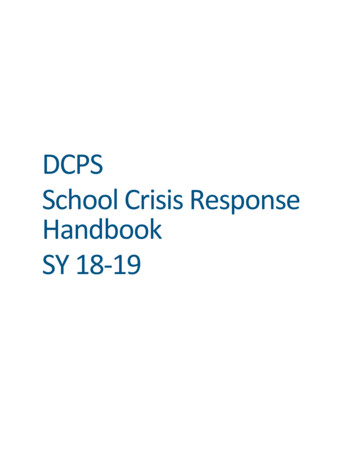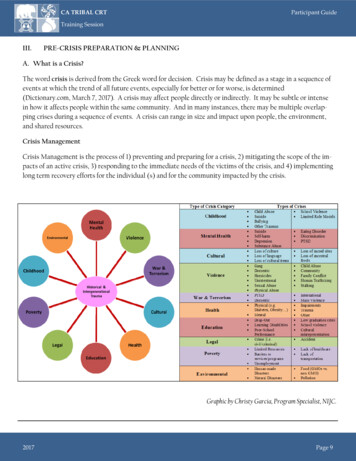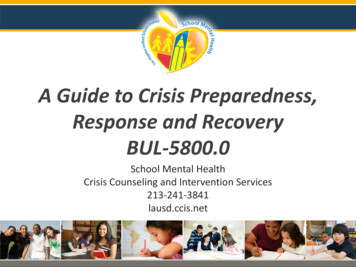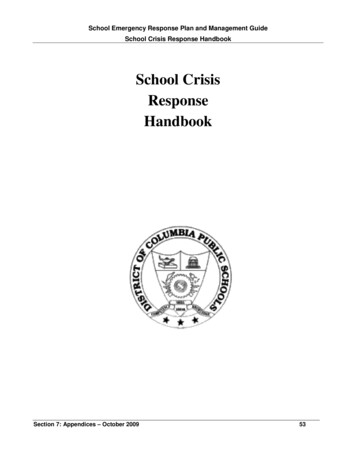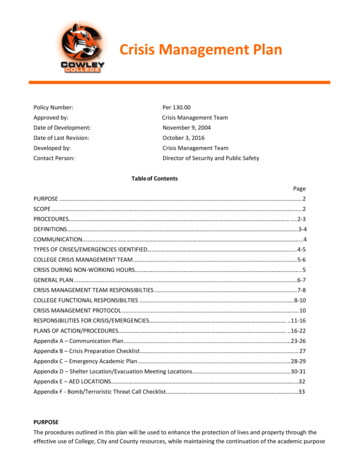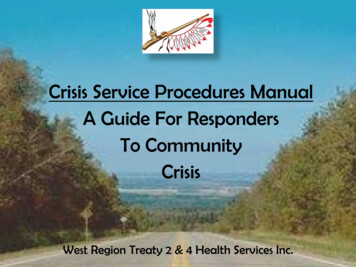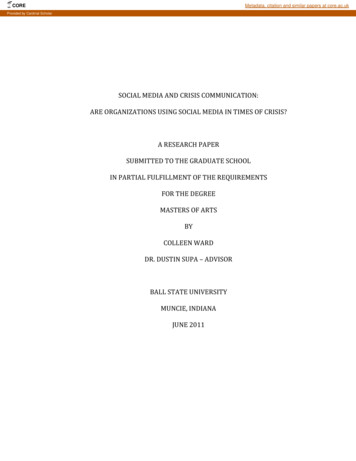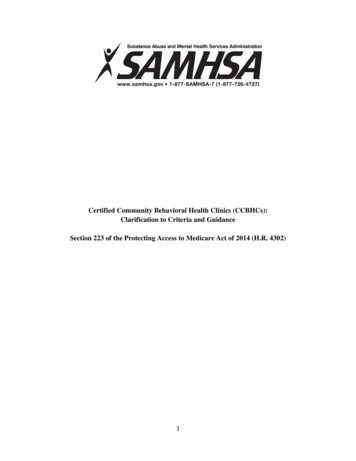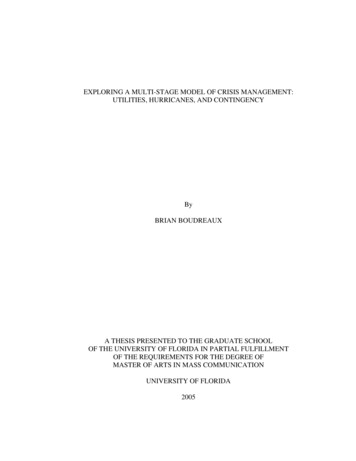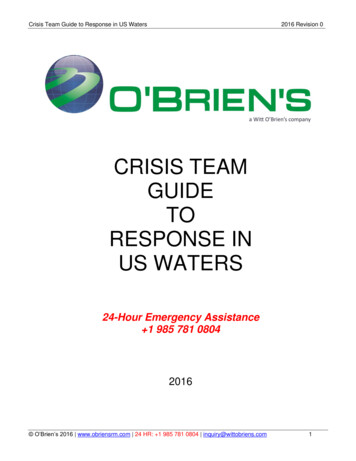
Transcription
Crisis Team Guide to Response in US Waters2016 Revision 0CRISIS TEAMGUIDETORESPONSE INUS WATERS24-Hour Emergency Assistance 1 985 781 08042016 O’Brien’s 2016 www.obriensrm.com 24 HR: 1 985 781 0804 inquiry@wittobriens.com1
Crisis Team Guide to Response in US Waters2016 Revision 0TABLE OF CONTENTSINTRODUCTION. 3YOUR PARTNERS IN RESPONSE . 3INCIDENT COMMAND SYSTEM (ICS) . 3RESPONSE SEQUENCE . 4COMMUNICATING WITH THE QUALIFIED INDIVIDUAL . 5SUGGESTIONS / COMMENTS / CLARIFICATIONS . 6APPENDIX 1 . 6APPENDIX 2 . 7“GOTOMEETING” INSTRUCTIONS . 7APPENDIX 3 . 8FILE TRANSFER PROTOCOL (FTP) INSTRUCTIONS . 8 O’Brien’s 2016 www.obriensrm.com 24 HR: 1 985 781 0804 inquiry@wittobriens.com2
Crisis Team Guide to Response in US Waters2016 Revision 0INTRODUCTIONIncident response in the US follows a well-established pattern. Government regulations require the use of theIncident Command System (ICS) for the management of all incidents. O’Brien’s is a worldwide leader in incidentmanagement of all types. O’Brien’s has developed CommandPro , a proprietary software developed “by respondersfor responders” to effectively and efficiently implement the ICS processes. The purpose of the Guide is to assist yourCrisis Team to be better prepared to cope with an incident in US waters. This Guide should be read in conjunctionwith the “Master’s Guide to Compliance in US Waters.”Information designed to save you time and effort is present in red italics.YOUR PARTNERS IN RESPONSEUSCG regulations require your company to have a Qualified Individual (QI) in theUS. Essentially the QI has two main responsibilities:The QI is your company’s main communications point from the beginning to the conclusion of an incident.1The QI has several regulatory responsibilities involving: Commencement of response activities. Management of response activities until an Incident Commander (IC) establishes a Incident2Management Team (IMT) acting in accordance with the Incident Command System (ICS). See belowfor more information about ICS and the ICS 207 Incident Organization Chart Form in Appendix 1. Notification of agencies as required by federal, state and local regulations.The Incident Commander (IC) is the leader of the Incident Management Team (IMT) along withINCIDENTthe Federal On-Scene Coordinator (FOSC), represented by the USCG and State On-SceneCOMMANDER Coordinator (SOSC). These three individuals form the Unified Command (UC).The IC is responsible for all aspects of the response activities.1He/She is responsible for the implementation of the Incident Command System (ICS) process.2QUALIFIED INDIVIDUALINCIDENT COMMAND SYSTEM (ICS)Government regulations require all incident response activities in the US to utilize the Incident Command System(ICS).O’Brien’s uses our CommandPro software to assist in this process. CommandPro helps to manage theprocess and automates many of the forms that document the ICS process. Many of these forms will be of use toyour Crisis Team and will be made available to you by the QI and IC.See our website for additional information: mandPro.INCIDENTThe USCG “Incident Management Handbook” is the definitive guide used by all responders inMANAGEMENT the US. It may be useful for your Crisis Team to have a copy.HANDBOOKYou may purchase a copy of the Incident Management Handbook from O’Brien’s. It can also be downloaded at:www.wittobriens.com/go/doc/2000/2457386.ICS TRAINING All incident managers in the US must be trained in ICS.1Basic training is available on-line at: http://training.fema.gov/IS/NIMS.asp.2We recommend the IS-100.b (ICS 100) Introduction to Incident Command System sp. O’Brien’s 2016 www.obriensrm.com 24 HR: 1 985 781 0804 inquiry@wittobriens.com3
Crisis Team Guide to Response in US Waters2016 Revision 0RESPONSE SEQUENCEThe USCG must be notified if there is a discharge of oil in/on the water or if there is aMANDATORY“substantial threat” of a discharge into the water. The USCG defines the following as aNOTIFICATION “substantial threat” including:123456789101112Grounding or stranding – even the slightest touch of the bottomCollision and allision – including a hard bump by a tug or a hard landing at a dockSpill on deck – any quantity that is enough for the oil to flow toward the railHull FailureExcessive ListContainment system failureSubmerged and founderedWrecked and strandedHazardous vapor releaseMachinery / Equipment malfunctions – steering, auxiliaries, fire pump, life boat, radar, radio, compass,cargo handling gear, etc.ExplosionFireUS law says that a “Person in Charge of a vessel” must notify the USCG if any of these situations exist. This“Person in Charge” can be the Master, the owner/operator, the DPA, the QI or another person who yourcompany policy says is “in charge” of your ship.The regulations say that this person must make notifications as soon as possible (without delay).Note: It is well established that the Qualified Individual may make the required notifications on behalf of theMaster. So you should contact O’Brien’s if you are in doubt and we’ll help determine whether the USCG andother agencies should be notified. Our contract with you requires us to ensure compliance with all laws andregulations. Please allow us to do this for you.WHAT THE QINEEDS TO KNOW1234567891011121314In order to provide the help you need, the QI will ask you for some important information.This includes:Your Name (Vessel Master)Telephone number, fax, email or other means of communicationVessel Name and IMO NumberVessel Owner/OperatorType of IncidentTime and date of incidentExact location (latitude/longitude if anchored or underway; port, slip and berth if in port)Type of oil spilled (try to be as specific, but knowing if it is clear or black is enough for the QI to get started).Estimated Quantity – we know this is difficult – we are looking for your best estimate. It is important for us toknow if this is a “very small” spill, a “very large” spill, or something in between.Is the source controlled / secured? YesNoBrief description of the situation (any other information or concerns you have).Death / Injuries to the crewDamage (extent to the vessel, facility, pier, other vessels, etc.)Confirm P&I Club membershipLocal Agents and their phone number O’Brien’s 2016 www.obriensrm.com 24 HR: 1 985 781 0804 inquiry@wittobriens.com4
Crisis Team Guide to Response in US Waters2016 Revision 0ICSPLANNINGPROCESSThe purpose of the ICS planning process is to move the incident response from anemergency response to a project management. The ICS planning process is objectivesbased and uses a series of formal meetings to produce an Incident Action Plan (IAP).The IAP provides specific direction to responders in the field. It is a compilation of avariety of different forms and topic specific plans (i.e. Safety Plan, Disposal Plan,Decontamination Plan, etc.). The IAP and supporting documents will be available to yourCrisis Team. Information about these many documents can be found in Appendix 1.INITIAL INCIDENTBRIEF(ICS 201)As the incident response progresses the QI will be creating the Initial Incident Brief (ICS201) form. This document is the basis for updates and briefings on the situation status. Itis a living document and is used to document the response activities until the IMT isestablished and the UC is ready to assume management of the response. The QI willthen provide a formal briefing to the UC. The UC will then assume responsemanagement and commence the ICS planning process.INITIAL RESPONSEAND ASSESSMENTAfter receiving notification of an incident many groups will be conducting an initialresponse and assessment. These include:Your Crisis/Emergency Response Team1Qualified Individual2Salvage and Marine Firefighting (SMFF) Resource Provider3USCG3State Agencies4If the initial assessment indicates that this may be a significant incident the QI will assemble the SMT, the UC isformed and a Command Post established. The QI will have a representative at the scene of the incident and alsoat the Command Post.COMMUNICATING WITH THE QUALIFIED INDIVIDUALTELEPHONEEmergency calls should go to our Command Center at our 24-hour number: 1 985 781 0804The QI will contact your Crisis Team by the telephone numbers listed in the Vessel Response Plan. Oncecommunications are established be sure you know:The name of the QI.1A primary and secondary telephone number for the QI.2If you have special telephone numbers for use by your Crisis Team be sure to pass them to the QI.As the incident progresses the QI will also use email to communicate with your Crisis Team. Inform theEMAIL QI if you have established a special email address for your Crisis Team.The QI will typically send two special messages to your Crisis Team that will provide you access to additionalinformation. They are a “GoToMeeting Request” and File Transfer Protocol (FTP) website instructions.The QI has the ability to initiate briefings held via web conference for your Crisis Team. In theGOTO“GoToMeeting” you will see the QI’s display. This allows the QI to provide a prepared briefing and toMEETING bring up other information as you might request. Appendix 2 has “GoToMeeting” information. O’Brien’s 2016 www.obriensrm.com 24 HR: 1 985 781 0804 inquiry@wittobriens.com5
Crisis Team Guide to Response in US WatersFTPSITE2016 Revision 0In this email the QI will provide instructions giving you access to a File Transfer Protocol (FTP) website.At this website you will be able to access and download the documents being created by the SMT usingthe ICS planning process; other documents, pictures, video etc. being accumulated by the SMT as wellas other items you might request from the QI. Appendix 3 has “Client Access” information.SUGGESTIONS / COMMENTS / CLARIFICATIONSCONTACTVESSELSERVICESThis document is intended to be a helpful guide for your Crisis/Emergency Response Team.Please help us make it more useful for you.If you have questions, comments or concerns please contact us at:inquiry@wittobriens.com.LIST1ICS FormsOFAPPENDICES2GoToMeeting Instructions3File Transfer Protocol InstructionsAPPENDIX 1Below is a partial list of the ICS forms that you may encounter. Those with importantinformation for the Crisis Team are highlighted in red. A copy of the ICS forms may bedownloaded here – www.wittobriens.com/go/doc/2000/1694515.Incident Report FormICS 201: Incident BriefingICS 202: Incident ObjectivesICS 203: Organization Assignment ListICS 204: Assignment ListICS 205: Incident Radio Communications PlanICS 205a: Communications ListICS 206: Medical PlanICS 207: Incident Organization ChartICS 208: Site Safety PlanICS 209: Incident Status SummaryICS 232: Resources at RiskICS FORMS O’Brien’s 2016 www.obriensrm.com 24 HR: 1 985 781 0804 inquiry@wittobriens.com6
Crisis Team Guide to Response in US Waters2016 Revision 0APPENDIX 2“GOTOMEETING” INSTRUCTIONSAs a response develops the QI will create the Incident Brief (ICS-201) form. Once this document isready the QI will send the Crisis Team an email with the subject “GoToMeeting Invitation – MeetNow.” This email provides instructions on how to participate in the GoToMeeting. Contact the QI bytelephone or email to arrange the specific time you would like to receive the Incident Brief from theQI. The email you receive will look similar to the example below:Internet access is required to conduct the GoToMeeting. Click on the link in the email and you will bedirected to the GoToMeeting website. The website is simple to use but requires that you downloadsoftware each time you attend a GoToMeeting. You may need to contact your IT staff if your systemwill not allow you to download the software.Here’s what the GoToMeeting screen will look like:You must run the software in order to join the GoToMeeting. Once you have run the software youshould be able to see the QI’s computer screen. The QI will then provide the Incident Brief. Thismeeting is being conducted to pass information to you. Be sure to ask the QI any questions you mayhave. At the end of the GoToMeeting you can disconnect by navigating away from the website. O’Brien’s 2016 www.obriensrm.com 24 HR: 1 985 781 0804 inquiry@wittobriens.com7
Crisis Team Guide to Response in US WatersRevision 02016APPENDIX 3FILE TRANSFER PROTOCOL (FTP) INSTRUCTIONSAs a response continues the QI and the SMT will create documents including videos, photographs, maps, pressreleases and other documents required by the Incident Command System. These documents will be madeavailable to the Crisis Team via a File Transfer Protocol (FTP) website. The QI will send an email withinstructions for accessing the FTP site.Internet access is required to access files on the FTP website. Open the instructions provided by the QI. Theywill contain your login ID and password specific to the incident. Click on the link in the email and you will bedirected to the O’Brien’s website. You may need to contact your IT staff if your system will not allow you toaccess the website.See the instruction that follow:FTP Access1) Go to:www.obriensrm.com2) Click on CLIENT LOGINS at the bottom of the page in the footer.3) Choose Client Download Site. O’Brien’s 2016 www.obriensrm.com 24 HR: 1 985 781 0804 inquiry@wittobriens.com8
Crisis Team Guide to Response in US WatersRevision 04)2016Choose File Portal.5) Enter Login Credentials.Once you have logged into the FTP site click on the “name” to access the available files.See the example on the following page: O’Brien’s 2016 www.obriensrm.com 24 HR: 1 985 781 0804 inquiry@wittobriens.com9
Crisis Team Guide to Response in US WatersRevision 020166) Click on File.The next screen will give you a listing of the available documents.7) Download the Documents.Click on the folder or files you want to access and follow the instructions to either download or viewthe file. If you download a large file or a file folder the system may provide them as a “zip” file. Thiswill require the use of WINZIP software to open the files. If you do not have WINZIP it is available at:www.winzip.com.It is intended that the FTP site be secure. You should not share the login ID or password withpersons outside your company. If you would like others to have access please contact the QI.He/She may permit you to allow access by sharing the current login and password, create a new FTPlogin or take some other action to provide access and still maintain security. O’Brien’s 2016 www.obriensrm.com 24 HR: 1 985 781 0804 inquiry@wittobriens.com10
The Incident Commander (IC) is the leader of the Incident Management Team (IMT) along with the Federal On-Scene Coordinator (FOSC), represented by the USCG and State On-Scene . The USCG "Incident Management Handbook" is the definitive guide used by all responders in
